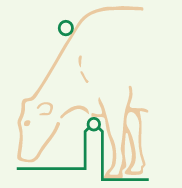Utilising the cow signals diamonds, we can identify six key freedoms of a cow; Feed, Water, Light, Air, Rest and Space. The concept is simple; understanding and rearing yours cows’ behaviour with the aim to improve surroundings, leading to increased yields, improve herd health and improved fertility rates.
Feed
Cows naturally graze throughout the day, rather than having ‘set meals’ like we do, so having constant access to feed is a crucial pillar of health on farms. The average cow consumes anywhere from 8-12 meals a day, anywhere up to 45 minutes per time. To ensure maximise DM intakes, we must provide 24-hour access to feed through regular push-ups and feed wall space. We recommend a slightly raised feed platform, with the brisket not being rubbed or knocked, and a slightly offset neck rail. This allows the cow to stretch down and eat comfortably. 
Sizing Recommendations
• Floor to neck rail: 125cm high, recess of 25cm
• Floor to brisket: 50cm
• Width of barrier: 8cm
• Brisket to feed table: 40cm
Water
It is vital that dairy herds have constant access to a supply of clean, fresh water. With over 85% of milk being water, a typical high-yielding dairy cow will drink upwards of 120 litres per day. We recommend the water trough is large enough for 10% of the herd to access at any one time.
Light
A lactating cow needs 16-18 hours of daylight (>200 lux) and 6-8 hours at <50 lux. However, for dry cows it’s the opposite; to help with issues of heat stress and to drive intakes.
Air
Good ventilation is imperative in housed cattle, with pneumonia and respiratory diseases being associated. Depending on shed design and location, ventilation by the wind will drive air through removing stale air, however your shed may require an outlet to promote better flow. Cobwebs, wet floors, damp sawdust/bedding and condensation on walls and roofing are all signs are reduced/poor ventilation. We can also look at reducing stocking densities to help with stagnant stale air. During the warmer months, faster breathing and lethargic animals are typically the first symptoms of heat stress in housed herds.
Space
Nothing should prevent cows from accessing feed, water or a bed, they should be free to socialise without any hindrance. Ideally, we want no dead-end alleys, tight cubicles or small feedwall space. In an ideal world, we recommend 1.25 square metres per 1000 litres produced; so an 8000L cow will need 10 square metres of space.
Rest
The optimum lying time for health and production in a 24 hour period is 14 hours. To achieve this, cubicles need to be of the correct design so that cows can enter, stand and lie squarely in them, and have adequate lunge room when standing. The difference between 9 hours lying time and 14 hours is an extra litre of milk production for each extra hour (Grant, 2003), with 30% more blood circulating through the udder.
Uncomfortable beds make cows reluctant to lie down, as well as potentially causing skin abrasions, joint inflammation and infection. Longer standing times lead to increased lameness and lower production, plus additional treatment costs. The drop knee test can be used to test cubical matting or mattress comfort, animals can also be timed from entry to the cubical to lying with a target of under 60 seconds.
Deep bedded sand, whilst bringing infrastructure challenges, would be deemed as the gold standard for optimum lying times. Deep bedded means sand should be front loaded over the brisket bar to encourage lying time and fluid drainage. Sourcing the correct grade of sand is paramount to avoid contamination, which can risk a rise in somatic cell counts.
